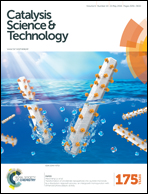Enhanced visible light driven photoelectrocatalytic oxidation of ethanol at reduced graphene oxide/CdS nanowires decorated with Pt nanoparticles†
Abstract
In this study, we report the preparation of a novel ternary hybrid consisting of reduced graphene oxide/CdS nanowires decorated with Pt nanoparticles (rGO/CdS NWs/Pt NPs) as an efficient electrocatalytic and photoelectrocatalytic ethanol oxidation platform in alkaline medium. The synthesis was accomplished by a solvothermal method in the first step to prepare uniformly sized CdS NWs with diameters of 35 nm and lengths up to several micrometers, followed by a simple hydrothermal method to assemble CdS NWs decorated with Pt NPs onto rGO sheets using hydrazine as a reducing agent. Data regarding the morphology, structure and properties of the prepared nanocomposite were obtained through various characterization techniques including field-emission scanning electron microscopy (FESEM), transmission electron microscopy (TEM), energy dispersive X-ray spectroscopy (EDX), X-ray diffraction (XRD), X-ray photoelectron spectroscopy (XPS), UV-visible and photoluminescence spectroscopy (PL). Assessing the electrocatalytic activity using cyclic voltammetry (CV) and amperometry techniques revealed that the ternary hybrid (rGO/CdS NWs/Pt NPs) exhibited superior electrocatalytic activity toward ethanol oxidation in alkaline solution with a more negative onset potential compared to nanostructures with various components such as CdS NWs, rGO/CdS NWs, CdS NWs/Pt NPs and rGO/Pt NPs. Furthermore, experiments using low-power LED as a visible-light illumination source showed a dramatic increase in the electrocatalytic activity of the proposed nanohybrid toward ethanol oxidation accompanied by a shift of the onset potential to a more negative potential of −0.950 V vs. Ag/AgCl compared to −0.870 V in dark condition. This high electrocatalytic and photoelectrocatalytic performance can be ascribed to providing maximum interfacial contact of CdS NWs with rGO, which decreases the agglomeration of nanostructures and suppresses the photogenerated electron–hole recombination. Furthermore, accelerated electron transfer in the presence of rGO and enhanced specific surface area achieved by uniform deposition of Pt NPs onto CdS NWs contribute to increasing the catalytic activity. This research could promise a simple strategy toward the synthesis of a one-dimensional semiconductor–rGO/Pt ternary hybrid and its applications as an efficient visible-light photocatalyst for different chemical transformation and energy conversion devices.


 Please wait while we load your content...
Please wait while we load your content...